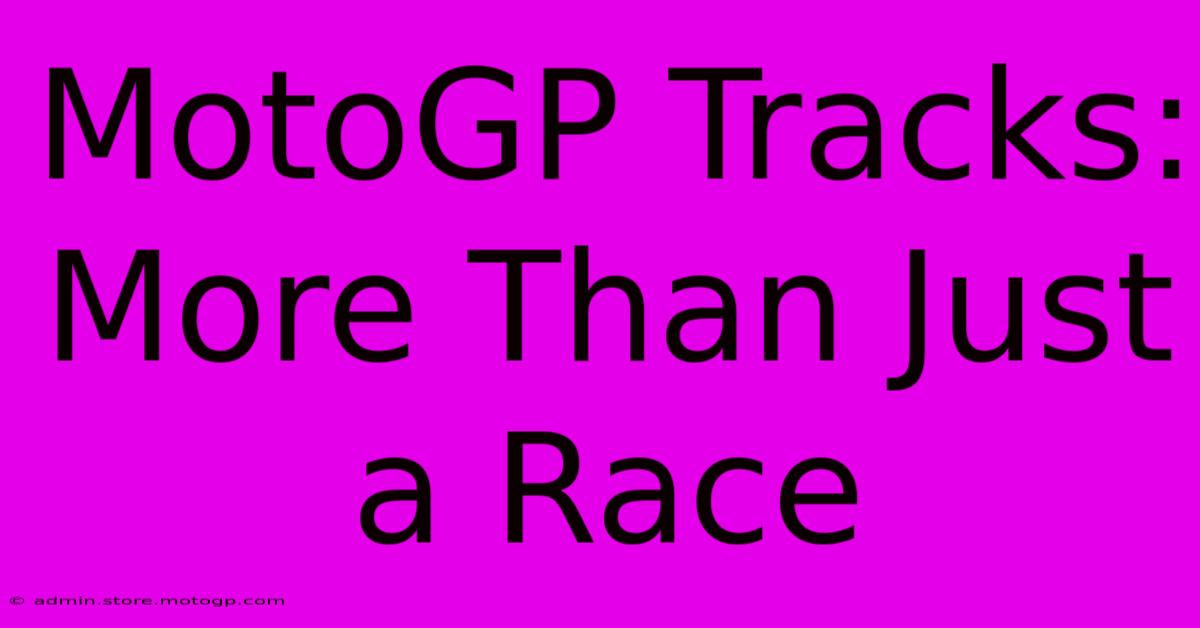MotoGP Tracks: More Than Just A Race

Table of Contents
MotoGP Tracks: More Than Just a Race
MotoGP. The name conjures images of screaming engines, breathtaking speeds, and nail-biting overtakes. But beyond the thrilling races themselves lies a world of fascinating details surrounding the tracks themselves. These aren't just stretches of asphalt; they are complex engineering marvels, steeped in history, and crucial to the outcome of each Grand Prix. This article delves deeper into what makes MotoGP tracks more than just a race venue.
The Engineering Marvels of MotoGP Circuits
Each MotoGP track is a testament to precision engineering. The design isn't arbitrary; it's carefully considered to provide a challenging and exciting race for the riders, while ensuring spectator safety and a thrilling viewing experience.
Key Design Elements:
-
Corner Radii and Banking: The varying radii of corners, combined with banking (the angle of the track's surface), determine the speed and the type of riding techniques required. Tight, hairpin bends demand precise control, while sweeping high-speed corners test the limits of both rider and machine. The banking helps riders maintain speed through corners without losing control.
-
Track Length and Layout: Track length significantly impacts race strategy. Longer tracks generally favor endurance and fuel management, while shorter circuits prioritize quick reflexes and overtaking opportunities. The layout itself—the sequence and types of corners—dictates different racing lines and overtaking zones.
-
Run-off Areas and Safety Features: Modern MotoGP tracks incorporate extensive run-off areas, gravel traps, and Tecpro barriers to maximize rider safety. These features are crucial in mitigating the risks associated with high speeds and potential crashes. Constant improvements and upgrades are made to enhance safety further.
-
Surface Composition and Grip: The track surface plays a crucial role in tire performance and rider control. The type of asphalt, its grip level, and its condition (affected by weather and tire wear) are factors that influence tire choices and race strategy.
The History and Heritage of Iconic Tracks
Many MotoGP tracks boast rich histories, steeped in legendary races and iconic moments. The names themselves evoke a sense of excitement and tradition.
Examples of Historically Significant Tracks:
-
Assen (Netherlands): Often called the "Cathedral of Speed," Assen has hosted motorcycle races since 1925, making it one of the oldest and most prestigious tracks on the calendar. Its history and unique character contribute to its legendary status.
-
Monza (Italy): While primarily known for Formula 1, Monza also holds a place in MotoGP history, with its high-speed layout and iconic banking.
-
Laguna Seca (USA): Famous for its iconic "Corkscrew" corner, Laguna Seca offers a challenging and visually stunning layout, providing spectators with breathtaking views and thrilling racing action.
These tracks aren't merely venues; they are living parts of motorcycle racing history, with each corner whispering tales of past victories and defeats.
The Impact of Tracks on Race Strategy
The characteristics of a specific track significantly influence race strategies. Teams meticulously analyze track data, weather forecasts, and tire wear to develop optimal race plans.
Strategic Considerations:
-
Tire Choice: Different tracks demand different tire compounds, depending on the level of grip, temperature, and cornering speeds.
-
Fuel Management: Longer tracks require careful fuel management to ensure the bike can complete the race without running dry.
-
Overtaking Opportunities: Identifying overtaking opportunities is crucial for race success. Some tracks offer more chances to overtake than others.
-
Mechanical Set-up: The bike's setup must be optimized for the specific characteristics of each track. This includes suspension settings, aerodynamic configurations, and engine mapping.
Understanding the nuances of each track is essential for both riders and teams to achieve success in the MotoGP World Championship. The choice of tires, fuel strategy, and mechanical setup are all heavily influenced by the unique layout and characteristics of each circuit.
Conclusion: More Than Asphalt and Rubber
MotoGP tracks are more than just venues for racing; they are intricately designed circuits that blend engineering precision, historical significance, and strategic complexity. They are the stages upon which legends are made and shattered, showcasing the skill, bravery, and technology at the heart of this exhilarating sport. Beyond the roar of the engines, it's the character and history of these tracks that add another layer to the excitement of MotoGP.

Thank you for visiting our website wich cover about MotoGP Tracks: More Than Just A Race. We hope the information provided has been useful to you. Feel free to contact us if you have any questions or need further assistance. See you next time and dont miss to bookmark.
Featured Posts
-
Vroom Vroom Any Racing On Tv Today
Feb 17, 2025
-
Yamaha Moto Gp Racing Staying Focused On The Goal
Feb 17, 2025
-
F1 Austin Optimize Your Viewing With Our Tv Schedule
Feb 17, 2025
-
Moto2 Standings Explained From Points To Podiums
Feb 17, 2025
-
Cota Qualifying Ignite Your Racing Spirit
Feb 17, 2025
